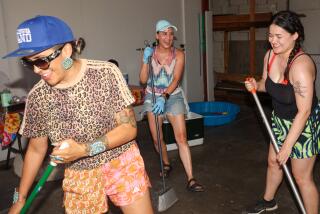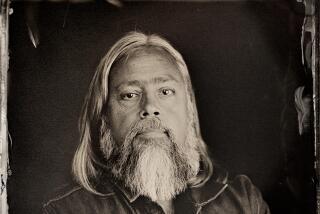How three generations of women artists in one indigenous family tell the story of a century of change
It’s an exhibition that tells the story of a family: a mother, her daughter and her daughter’s daughter. It also tells the story of settlement, of a fur-trading outpost in the frigid Canadian Arctic transformed into an unlikely print-making center. And it tells a story of the Inuit people, of a community at the moment of rupture, when tradition rapidly gave way to encroaching European influence.
“Akunnittinni: A Kinngait Family Portrait,” at the Armory Center for the Arts in Pasadena through the middle of December, presents work by three generations of artists from a single Inuit family: Pitseolak Ashoona, Napachie Pootoogook and Annie Pootoogook. All were born and raised in Cape Dorset, Nunavut (current population 1,400), a sparse settlement off the Northwest Passage that is closer to Greenland than it is to much of the Canadian mainland.
Collectively, their work — including keenly observed renderings of Arctic wildlife, Inuit tradition and private domestic scenes — weaves together more than a century of personal, political and cultural life in the Arctic, an engrossing narrative arc of indigenous life over a period of tumultuous change.
“You can understand the harshness of it and the difficulty of it,” says exhibition curator Andrea Hanley, “but the beauty of it too.”
The story begins with Ashoona, who was born circa 1904, almost a decade before the Hudson Bay Co. opened a trading post in Cape Dorset, a seaside settlement known as Kinngait in the native Inuktitut language. For much of her youth, Ashoona and her family adhered to traditional nomadic life and its rhythm of seasonal moves in search of fresh hunting grounds — themes reflected in her work until her death in 1983.
Her prints feature hunting scenes, celebrations and mythical spirits. A print made the year of her death, “Migration Towards Our Summer Camp,” depicts a bundled family ready to make the trek to a new location. Smiling men clutch arrows, dogs bear packs full of goods, children strike playful poses — all against a field of white. “It really talks about community and what that means,” says Hanley.
Ashoona once described her art as recording “the things we did long ago before there were many white men.”
By the time Ashoona’s daughter, Napachie Pootoogook was born in 1938, Inuit life was undergoing radical changes. What had once been a nomadic, subsistence culture was becoming increasingly dependent on European trade. When the fur business went into steep decline in the 1940s and ’50s, so did the fortunes of countless Arctic settlements. The Canadian government, in the meantime, continued to encourage Inuit people to settle in villages — a move that made bureaucratic administration easier from a distance, but chipped away at traditional life. For many Inuit, daily life became a cycle of grinding poverty.
In Cape Dorset, however, economic survival came through art.
In the late 1940s, James Houston, a charismatic Canadian mainlander, settled in the area and, intrigued by Inuit carving traditions, began to acquire and promote the work in Montreal’s cultural institutions. By the late 1950s, he had founded the West Baffin Eskimo Co-Operative, a print-making studio in Cape Dorset. His successor, Terry Ryan, worked to establish a business arm for the studio in the 1970s: Dorset Fine Arts in Toronto, which helped market and distribute artists’ work. Cape Dorset became the so-called capital of Inuit art.
“There was this huge issue related to livelihoods after the fur trade had died,” Hanley says. “In the 1950s, it was people trying to create this workforce of artists. They were doing lithography and silk-screening and they were drawing. There was a significant market for it in mainland Canada.”
For Ashoona, who found herself a widow and a single mother after her husband died from a viral infection in the 1940s, the printmaking studio was not only an important site of self-expression but it also proved an economic lifeline.
For her daughter Napachie, it was also essential. (Early on, Ashoona encouraged her daughter to draw, and her sons became sculptors.) Like her mother, Napachie, who died in 2002, also straddled two significant eras during her 64 years: the traditional nomadic life of her early youth, followed by an adulthood spent almost entirely in Cape Dorset.
Napachie’s drawings and prints engaged tradition, depicting Inuit games and mythological figures, as her mother did. But she accomplished this in ways that featured unusual perspectives (she regularly employed omniscient overhead views) and graceful details — the blocks of an igloo, for example, that seem to envelope their human figures like architectonic wombs.
But while she was reverent, she was also unflinching, recording the harsh realities of everyday life: a sailing ship split in two on a reef, or Inuit men trading their women to Europeans for a handful of goods. In the 1994 drawing “Alcohol,” on view at the Armory, she shows a woman clutching a baby and attempting to seize a bottle from a drunken man. Another figure lies passed out on the floor. (Alcohol has been a devastating force among indigenous communities in the Arctic.)
“I think Napachie really wanted to tell the story of what it was to be an indigenous woman in her time and to document it,” Hanley says. “She wanted people to understand — for women who suffered, for women who survived.”
By the time Napachie’s own daughter Annie Pootoogook was born in 1969, life in the Arctic had irrevocably changed for indigenous people. Annie came of age in an era of gas-powered snowmobiles and consumer electronics. Like her mother and grandmother, she too became an artist, but her flat, colorful drawings don’t recall legends; they are instead a record of daily Inuit life at the turn of the 21st century.
Annie shows families sharing meals of seal meat while seated on the floors of Western-style homes and a clutch of shoppers gazing at the freezer section of a supermarket in a location where temperatures can dip to minus 25 degrees Fahrenheit in winter. In one image at the Armory, a man helps a woman place an infant on her back in a traditional parka. At their feet, another child watches “The Simpsons.”
Annie’s wry depictions of life in Cape Dorset, says Hanley, “changed what people thought of as Inuit art.”
They also drew the attention of the broader art world. In 2006, she received a prestigious Canadian Sobey Award, which came with a $50,000 prize. She went on to show her work at the Montreal Biennale and Documenta, the every-five-years exhibition in Kassel, Germany.
But Annie’s work wasn’t simply about mundanities. Like Napachie, Annie was clear-eyed about the problems her community faced. In her vibrant drawings, there is disaffection, violence and alcoholism. She herself struggled with the latter, accompanied by spells of homelessness. In 2016, she was found dead at age 47 in Ottawa’s Rideau River. The police investigation into her death was inconclusive.
It’s coming from this tribal context, this indigenous feminist context. You get a sense of what it is to be an Indian woman.
— Andrea Hanley, curator
“Akunnittinni” is not a full-blown survey of the three artists’ work. Ashoona, her daughter and granddaughter were, by all accounts, prolific artists, each creating thousands of prints and drawings during their careers. The show, which originated at Santa Fe’s Museum of Contemporary Native Arts at the Institute of American Indian Arts (where Hanley serves as program manager), instead draws narrowly from works held by Dorset Fine Arts and a private collector of Native American art in New York.
But what is on view nonetheless represents a moving and intimate artistic dialogue.
Hanley, an enrolled member of the Navajo Nation, says she sees her own experience reflected in the drawings on the museum’s walls.
“I come from a matrilineal tribe,” she says. “I was really drawn to this idea of generations of these indigenous women; they were all coming from one family, and it’s a really strong family voice. But they’re each very different. It’s coming from this tribal context, this indigenous feminist context. You get a sense of what it is to be an Indian woman.”
“It’s survival,” she adds thoughtfully. “It’s resilience.”
Among the works presented in the show is a simple 2006 collograph print by Annie that depicts her grandmother’s eyeglasses — the object through which Ashoona observed her shifting world.
The eyeglasses survive as a line, printed on paper. But they also serve as a line between one artist and another, between one woman and another, between indigenous people who have weathered unrelenting change.
It is from this idea that the exhibition gets its name. In Inuktitut, “Akunnittinni” translates to “between us.”
“Akunnittinni: A Kinngait Family Portrait”
Where: Armory Center for the Arts, 145 N. Raymond Ave., Pasadena
When: Through Dec. 16
Info: armoryarts.org
ALSO
The best of times, the worst of times: art in the age of rising white supremacy
In advance of the midterms, Barbara Kruger reprises MOCA mural that asks ‘Who is beyond the law?’
Sign up for our weekly Essential Arts & Culture newsletter »
[email protected] | Twitter: @cmonstah
More to Read
The biggest entertainment stories
Get our big stories about Hollywood, film, television, music, arts, culture and more right in your inbox as soon as they publish.
You may occasionally receive promotional content from the Los Angeles Times.











